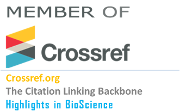Xenotransplantation: past, present, and future directions
Abstract
Xenotransplantation, in its broadest sense, is the transplantation, implantation, or infusion of cells, tissues, or organs from one species to another. While there is a high demand for human tissues, cells, and organs for use in clinical transplantation, they are often in short supply. Recent scientific and biotechnological advancements, coupled with the scarcity of human allografts, have led to renewed interest in developing exploratory treatment strategies that use xenotransplantation products in human recipients. However, despite its potential benefits, the use of xenotransplantation is still limited due to various considerations, as discussed in this review of the past, present, and future directions of xenotransplantation. One of the key ethical concerns surrounding xenotransplantation is the potential impact on the animals from which the cells, tissues, or organs are obtained. As with genetic modification to fix genetic defects or prevent disease, the ideal outcome for these animals is that they will be better off as a result of the change. However, unless there are major changes in the way science is taught to incorporate ethics into recognized scientific theory and practice, these concerns will not be adequately addressed
Keywords
Full Text:
View Full TextReferences
White S, Hirth R, Mah’illo B, Dom’inguez-Gil B, Del- monico F, Noel L, et al. The global diffusion of organ trans- plantation: trends, drivers and policy implications. Bulletin of the World Health Organization. 2014;92:826-35.
Ekser B, Ezzelarab M, Hara H, van der Windt D, Wijkstrom M, Bottino R, et al. Clinical xenotransplantation: the next medical revolution? The lancet. 2012;379(9816):672-83.
O’Flaherty W. Hindu Myths: A Sourcebook Translated from the Sanskrit. Hammondsworth: Penguin; 1975.
Kahan B. Ganesha: the primeval Hindu xenograft. In: Transplantation proceedings. vol. 3. Elsevier; 1989. p. 1-8.
Bhandari M, Tewari A. Is transplantation only 100 years old? British journal of urology. 1997;79(4):495-8.
Deschamps JY, Roux FA, Saï P, Gouin E. History of xeno- transplantation. Xenotransplantation. 2005;12(2):91-109.
Denis J. ’Excerpt from a letter from Mr. Denis, Profes- sor of Philosophy & Mathematics, aM*** concerning blood transfusion,”;6(1667):69-72.
Kissam R. Ceratoplastice in man. NYJ Med. 1844 Mar;2:281-2.
Zirm E. Eine erfolgreiche totale keratoplastik (A success- ful total keratoplasty). Journal of Refractive Surgery. 1989 Jul;5(4):258-61.
Hara H, Cooper D. Xenotransplantation: the future of corneal transplantation? Cornea. 2011 Apr;30(4):371.
Haq M. Fish cornea for grafting. British medical journal. 1972 June;2(5815):712.
Reemtsma K, McCracken B, Schlegel J, Pearl M, Pearce C, DeWitt C, et al. Renal heterotransplantation in man. Annals of surgery. 1964 Sep;160(3):384.
Hardy J, Chavez C, Kurrus F, Neely W, Eraslan S, Turner M, et al. Heart transplantation in man: developmental studies and report of a case. Jama. 1964 Jun;188(13):1132-40.
Bailey L, Nehlsen-Cannarella S, Concepcion W, Jolley W. Baboon-to-human cardiac xenotransplantation in a neonate. Jama. 1985 Dec;254(23):3321-9.
Starzl T, Fung J, Tzakis A, Todo S, Demetris A, Marino I, et al. Baboon-to-human liver transplantation. The Lancet. 1993 Jan;341(8837):65-71.
Yoon C, Choi H, Kim M. Corneal xenotransplantation: Where are we standing? Progress in retinal and eye research. 2021 Jan;80:100876.
Wang Y, Lei T, Wei L, Du S, Girani L, Deng S. Xenotrans- plantation in China: present status. Xenotransplantation. 2019 Jan;26(1):e12490.
Cooper D, Hara H, Yazer M. Genetically engineered pigs as a source for clinical red blood cell transfusion. Clinics in Laboratory Medicine. 2010 Jun;30(2):365-80.
Roux F, Saï P, Deschamps J. Xenotransfusions, past and present. Xenotransplantation. 2007 May;14(3):208-16.
Cooper D, Hara H, Yazer M. Genetically engineered pigs as a source for clinical red blood cell transfusion. Clinics in Laboratory Medicine. 2010 Jun;30(2):365-80.
Murthy R, Bajona P, Bhama J, Cooper D. Heart xenotrans- plantation: historical background, experimental progress, and clinical prospects. The Annals of Thoracic Surgery. 2016 Apr;101(4):1605-13.
Gibson T. Zoografting: a curious chapter in the history of plastic surgery. British Journal of Plastic Surgery. 1955 Jan;8:234-42.
Cooper D. Xenografting: the early, early years. Xeno. 1997;5:21-2.
Knapp EC. The first corneal transplant. Cornea. 1989;8(2):107-8.
Hara H, Cooper D. The immunology of corneal xenotrans- plantation: a review of the literature. Xenotransplantation. 2010 Sep;17(5):338-49.
Khan AJ, Dohlman AT, Chew DW. Corneal xenotrans- plantation: a review. Current Opinion in Ophthalmology. 2010;21(6):582-6.
Spalton LA. Corneal xenotransplantation: an ethical perspective. Progress in Retinal and Eye Research. 2013;33:101-11.
Khan AJ, Dohlman AT, Chew DW. Corneal xenotransplan- tation: challenges and opportunities. American Journal of Transplantation. 2014;14(2):367-76.
Hamilton D. The monkey gland affair. Chatto Windus; 1986.
Poncelet A, Denis D, Gianello P. Cellular xenotransplan- tation. Current Opinion in Organ Transplantation. 2009 Apr;14(2):168-74.
Matevossian E, Kern H, Hüser N, Doll D, Snopok Y, Nährig J, et al. Surgeon Yurii Voronoy (1895-1961) - a pioneer in the history of clinical transplantation: in memoriam at the 75th anniversary of the first human kidney transplantation. Transplantation International. 2009 Dec;22(12):1132-9.
Lee R. The Bizarre Careers of John R. Brinkley. University Press of Kentucky; 2002.
Sgroi A, Bühler L, Morel P, Sykes M, Noel L. Interna- tional human xenotransplantation inventory. Transplanta- tion. 2010 Sep;90(6):597-603.
Starzl T, Marchioro T, Peters G, Kirkpatrick C, Wilson W, Porter K, et al. Renal heterotransplantation from baboon to man: experience with 6 cases. Transplantation. 1964 Nov;2:752.
Taniguchi S, Cooper D. Clinical xenotransplantation: past, present and future. Annals of the Royal College of Surgeons of England. 1997 Jan;79(1):13-9.
Barnard C, Wolpowitz A, Losman J. Heterotopic cardiac transplantation with a xenograft for assistance of the left heart in cardiogenic shock after cardiopulmonary bypass. South African Medical Journal. 1977 Dec;52(26):1035-8.
Burdorf L, Riner A, Rybak E, II S, De Meyer S, Shah A, et al. Platelet sequestration and activation during GalTKO. hCD46 pig lung perfusion by human blood is primarily mediated by GPIb, GPIIb/IIIa, and von Willebrand Factor. Xenotransplantation. 2016 May;23(3):222-36.
Laird C, Burdorf L, French B, Kubicki N, Cheng X, Braileanu G, et al. Transgenic expression of human leukocyte antigen-E attenuates GalKO.hCD46 porcine lung xenograft injury. Xenotransplantation. 2017;24(2):e12294.
Starzl T, Marchioro T, Faris T, McCardle R, Iwaski Y. Av- enues of future research in homotransplantation of the liver with particular reference to hepatic supportive procedures, antilymphocyte serum, and tissue typing. The American Journal of Surgery. 1966 Sep;112(3):391-400.
Starzl T, Ishikawa M, Putnam C, Porter K, Picache R, Hus- berg B, et al. Progress in and deterrents to orthotopic liver transplantation, with special reference to survival, re- sistance to hyperacute rejection, and biliary duct reconstruc- tion. Transplantation proceedings. 1974 Dec;4(1):129. NIH Public Access.
Giles G, Boehmig H, Amemiya H, Halgrimson C, Starzl T. Clinical heterotransplantation of the liver. Transplantation proceedings. 1970 Dec;2(4):506. NIH Public Access.
Makowka L, Wu G, Cramer D, Hoffman A, Podesta L. Im- munohistopathologic lesions associated with the rejection of a pig-to-human liver xenograft. Transplantation proceed- ings. 1994;26(3):1074-5.
Groth C, Tibell A, Tollemar J, Bolinder J, Östman J, Möller E, et al. Transplantation of porcine fetal pancreas to diabetic patients. The Lancet. 1994 Nov;344(8934):1402-4.
Allan J. Xenotransplantation at a crossroads: prevention versus progress. Nature Medicine. 1996 Jan;2(1):18-21.
Vanderpool H. Critical ethical issues in clinical trials with xenotransplants. The Lancet. 1998 May;351(9112):1347- 50.
Hughes J. Xenografting: ethical issues. Journal of Medical Ethics. 1998 Feb;24(1):18-24.
Delriviere L, Havaux X, Gibbs P, Gianello P. Basic anatomical and physiological differences between species should be considered when choosing combinations for use in models of hepatic xenotransplantation: an investigation of the guinea pig-to-rat combination. Transplantation. 1998 Jul;66(1):112-5.
Robson S, Am Esch J, Bach F. Factors in xenograft rejec- tion. Annals of the New York Academy of Sciences. 1999 Jun;875(1):261-76.
Adin C, Gilor C. Focus: Comparative medicine: the di- abetic dog as a translational model for human islet trans- plantation. The Yale journal of biology and medicine. 2017 Sep;90(3):509.
Platt J, Cascalho M, Piedrahita J. Xenotransplantation: progress along paths uncertain from models to application. ILAR journal. 2018;59(3):286-308.
Ding D, Chou H, Chang Y, Hung W, Liu H, Chu T. Charac- terization of HLA-G and related immunosuppressive effects in human umbilical cord stroma-derived stem cells. Cell transplantation. 2016;25(2):217-28.
Lévêque X, Mathieux E, NerrièreDaguin V, Thinard R, Ker- marrec L, Durand T, et al. Local control of the host immune response performed with mesenchymal stem cells: perspec- tives for functional intracerebral xenotransplantation. Jour- nal of cellular and molecular medicine. 2015;19(1):124-34.
Yang J, Liao C, Pang C, Huang L, Chen Y, Shiue Y, et al. Transplantation of porcine embryonic stem cells and their derived neuronal progenitors in a spinal cord injury rat model. Cytotherapy. 2013;15(2):201-8.
Medicetty S, Bledsoe A, Fahrenholtz C, Troyer D, Weiss
M. Transplantation of pig stem cells into rat brain: Prolif- eration during the first 8 weeks. Experimental neurology. 2004;190(1):32-41.
Li K, Wang Y, Sun Q, Li M, Chen J, Liu L. Rabbit umbilical cord mesenchymal stem cells: A new option for tissue engi- neering. The Journal of Gene Medicine. 2021;23(1):e3282.
Jia Y, Zhao Y, Wang L, Xiang Y, Chen S, Ming C, et al. Rat adipose-derived stem cells express low level of s´-Gal and are dependent on CD59 for protection from human xenoan- tibody and complement-mediated lysis. American Journal of Translational Research. 2016;8(5):2059.
Bozoglanian V, Butteri M. The diverse and promising world of animal derived medications. Pharos Alpha Omega Alpha Honor Med Soc. 2015 Jan:16-22.
Anjum C, Chia Y, Chan M. Presence of Neu5Gc in Animal- Derived Products. Friend Or Foe. Stem Cells Regen Med. 2020;4(1):1-7.
DOI: https://doi.org/10.36462/H.BioSci.202205
Refbacks
- There are currently no refbacks.
Copyright (c) 2022 Eissa et al.

This work is licensed under a Creative Commons Attribution 4.0 International License.
...........................................................................................................................................................
Other "Highlights in" Journals
Highlights in Bioinformatics, Highlights in Chemistry, Highlights in Science, Highlights in Microbiology, Highlights in Plant Science
........................................................................................................................................
International Library of Science "HighlightsIn" is an Open Access Scientific Publishers, aiming to science and knowledge support













